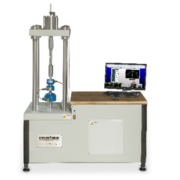Load Cells for Adhesive and Bonding Shear Testing
 Thousands of adhesives and bonding agents are used to assemble parts and final goods. In addition to their bonding characteristics, they may be required to have a certain elasticity, resistance to chemicals, electrical conductivity, temperature coefficient, or other controlled parameters.
Thousands of adhesives and bonding agents are used to assemble parts and final goods. In addition to their bonding characteristics, they may be required to have a certain elasticity, resistance to chemicals, electrical conductivity, temperature coefficient, or other controlled parameters.
A shear testing machine uses a load cell to measure the shear strength of bonds and adhesives. A load cell transforms bond and adhesive tests from a subjective evaluation of adhesion strength into a precise and objective measurement tool. This allows various industries to make data-driven decisions regarding adhesive selection, formulation optimization, and quality control.
Specifically, adhesive or bonding shear force testing is used to evaluate the strength of a joint formed by an adhesive between two materials. It measures the force required to separate the bonded materials by a sliding motion parallel to the adhesive joint instead of pulling them directly apart to measure tensile strength or peeling them from one another, which defines the peel strength.
Benefits of Using Load Cells for Adhesive and Bonding Shear Force Testing
- Material Characterization: Shear testing data helps characterize the shear properties of adhesives and the materials they bond. This information is valuable for selecting appropriate adhesives for specific applications and predicting their performance under stress. Read more in Interface Solutions for Material Testing Engineers.
- Improved Design and Development: The data from shear testing informs researchers, product designers, product development teams, and engineering of new adhesives and bonded products. By understanding how different materials and adhesives perform under shear stress, engineers can optimize designs for better performance and durability.
- Failure Detection: Product manufacturers can identify the bond’s failure mode by analyzing the force data. Did the adhesive itself fail? Did the bonded materials detach during the test? When did the failure occur? This quantifiable information helps understand the weak points and prepare improvements before assembly and product release.
- Quality Control: Manufacturers must validate consistent bond strength across production batches. By performing standardized shear tests with a load cell, the data helps maintain product quality and prevent potential production, distribution, and use failures.
What is Peel Strength Testing?
The peel test is common for adhesives, adhesive-coated tapes, and paints. The test parameters are usually detailed in a government or industry specification, and the pull rate is often closely controlled. Adhesive-backed tapes are tested this way.
Many industries rely on standardized peel test methods for quality control. Load cells are used for reliable peel testing and quality assurance analysis. The load cell data can be captured electronically, allowing you to analyze the force variations throughout the peeling process, not just the peak force. This can reveal aspects like initial adhesion strength or how the force changes as the peel progresses.
During a peel test, you need a way to measure the force required to precisely separate two bonded materials. Unlike a simple hand pull, a load cell quantifies the peeling force. This allows you to analyze the results numerically and compare them to specifications or between different samples. This is an important step in R&D for all parts, components, and final products.
Building a Shear Testing Machine
The design of a shear tester is relatively straightforward if the following conditions are met:
- The line of action of the primary axis of the load cell should be aligned with the contact point on the test sample to minimize moment loads on the load cell.
- The linear bearing motion should be carefully adjusted to run exactly parallel with the primary axis of the load cell to avoid a side load into the load cell.
- The load cell’s capacity should be at least twice the expected maximum load to be applied during a test cycle to provide enough extra capacity to protect the cell when a sudden failure of the test sample impacts it.
- The linear drive should have a wide range of controlled speeds and a high-resolution displacement measuring capability, including an
- Usan an automatic adjustable stop with fast braking to protect the load cell from damage. The usual system is a stepper motor drive with precision high-ratio reduction gear.
For additional information about shear testing, an illustration of the shear testing machine, and peel tests, please use the Interface Load Cell Field Guide.
If you have questions about choosing the right load cell for your machine or test, consult with our application engineers. You can also reference our easy-to-use Load Cell Selection Guide.
ADDITIONAL RESOURCES
Why Machine and Equipment Manufacturers Choose Interface
Load Cells Built for Stress Testing
Force Measurement Testing Improves Products and Consumer Safety








